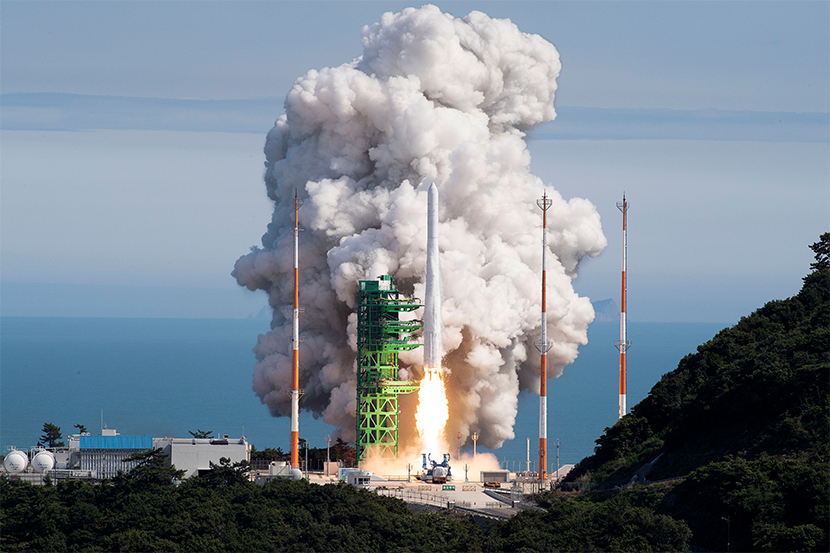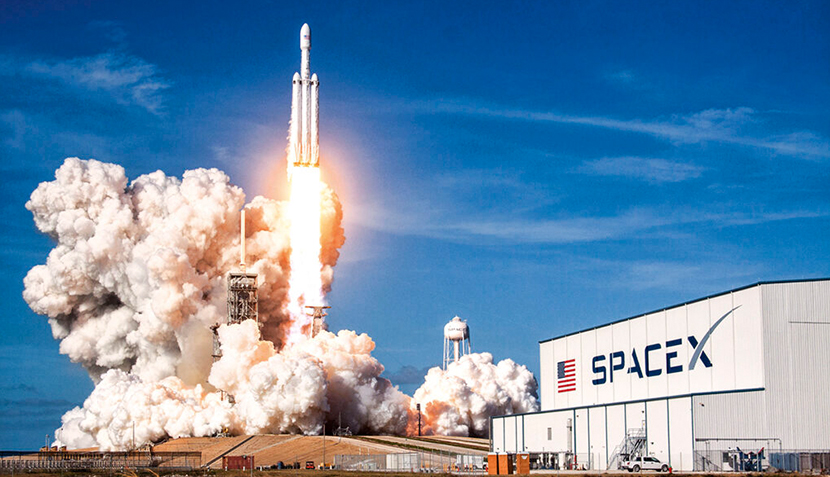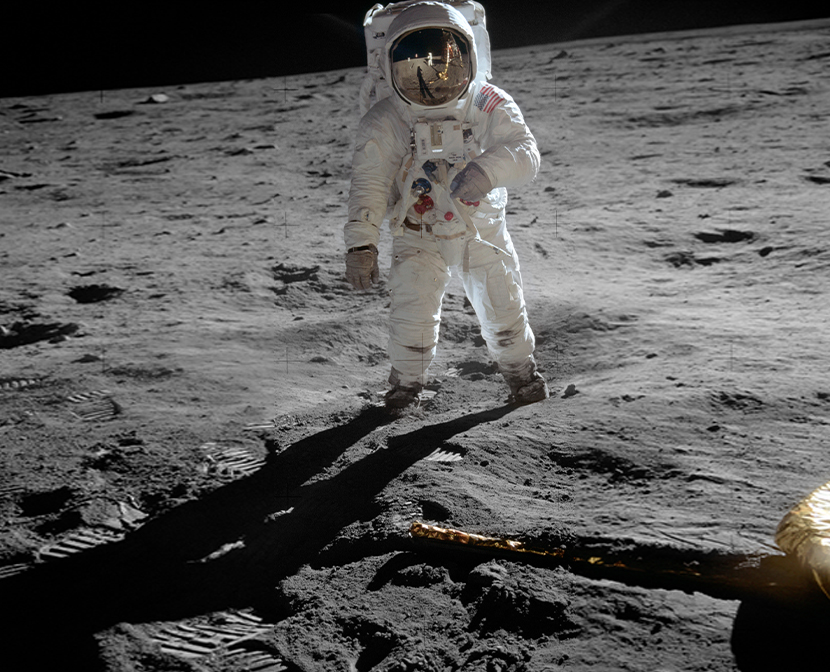With the June launch of the Nuri rocket, Korea became the seventh country in the world to put a satellite into orbit. The Nuri launch was followed in August by the launch of Danuri, Korea’s first lunar orbiter. Perhaps we are closer than ever before to making space travel a reality! Read on to find out what the successful launch of the Nuri rocket means for today’s aerospace industry.
“All for one, and one for all!”
Following the successful launch of the Nuri rocket, what resounded in my mind was the motto of The Three Musketeers: “All for one, and one for all!” In order to make it into space, a rocket must maintain enough speed to overcome Earth’s gravitational pull. The 75-ton, liquid-propellant engine that powered Nuri was a globally noteworthy development, but the power of a single engine is not enough by itself for Nuri to overcome Earth’s gravity. Nuri’s four engines, a core technology of the rocket, function as one to create 300 tons of thrust. The successful launch of Nuri marks Korea’s first independent steps into space exploration, with further developments for lunar and deep-space rocket development expected to follow.
How about a BLT with that space launch?
On August 5, Korea succeeded in launching its first lunar orbiter, Danuri, into space. The secret technology powering Danuri shares its name with the popular sandwich, the BLT. Short for “Ballistic Lunar Transfer,” Danuri’s BLT is a technology used to send Danuri into the Moon’s orbit over a much longer period of time than direct transfer methods. It only takes about three days to travel from Earth to the Moon in a straight line, but with BLT, the trip takes 135 days. Even though it takes longer, BLT is used because it works with gravity, instead of against it, to reduce fuel consumption by about 25%. The same principle applies to regular trains vs. fancy high-speed trains—the regular trains may take longer, but they cost less. Many people say it is about the journey, not the destination, but passing through the Lagrange point before entering the Moon’s orbit, is anything but easy. Difficult journey aside, Danuri builds upon the technologies used to create Nuri and embodies Korea’s finest aerospace technologies, and was created as a result of a partnership between the Korea Aerospace Research Institute and NASA. The rocket is expected to make it into the Moon’s orbit safe and sound sometime in December 2022.
Bezos and Musk look to space
Jeff Bezos and Elon Musk, two of the most successful entrepreneurs in history, have once again been thrust into the global limelight—this time because of their space aspirations. When it comes to space, the two men share the same daring sense of adventure. Having grown up in the era of the Apollo space program, both men seem to have cultivated a thirst for space exploration that they are now making efforts to quench.
Bezos’s interest in space travel centers around the Moon, while Musk envisions colonizing Mars. Through his aerospace company Blue Origin, Bezos has laid the foundation for zero-gravity space travel and is working with NASA to once again taking humans to the Moon. Meanwhile, Musk’s Mars-ward aspirations have driven him to establish SpaceX, a company through which he became the first civilian to launch a rocket into orbit. Building upon this achievement, Musk is now aiming to colonize Mars before the turn of the century.
Bezos’s and Musk’s efforts may be seen as unusual by more practical-minded businessmen and women, since space exploration does not yet hold much commercial value, if any. A business endeavor is said to have commercial value if the revenue it produces exceeds the amount of money spent. Drones, another relatively new technology, have found a niche in logistics, passenger transport, and defense, despite many people’s initial dismissal of drones as mere toys. Perhaps in a similar way, Bezos and Musk, who are hailed by the world as geniuses, are seeing much further ahead than the rest of us with their space projects.
Successful launch of Falcon 9 of SpaceX(www.spacex.com) in May 2020 (Source: SpaceX)
The Moon as a hub of space travel
When I was in school, the TV series The Last Match and the Japanese comic Slam Dunk, both of which were about basketball, left quite a mark on our impressionable minds, and all the kids in my school began playing basketball. For most kids, the slam dunk was the pinnacle of all that was beautiful and desirable about basketball. I thought the reason that I couldn’t slam dunk was because I was short, but when I saw that Allen Iverson, who was similar to me in height, could slam the ball into the net from above the rim, I realized that my height wasn’t the problem. So, once space exploration efforts become full-fledged, there may come a time when space travel is much easier and accessible, allowing everyone to achieve a so-called “slam dunk” in space exploration.
The gravity of the Moon, the target of Danuri’s mission, is only about one-sixth that of the Earth’s. Even today, there are some conspiracy theorists who claim that Apollo 11’s Moon landing in 1969 was a hoax. If you understand how the Moon’s gravity works, you will be able to understand that the first Moon landing was real. The fact that the gravitational pull of the Moon is weaker than that of the Earth’s is far more significant than my ability—or inability—to do a slam dunk. The rockets we fire into space have to be enormous in size in order to break free from Earth’s gravitational pull, but what if we were to launch rockets from the Moon instead of from the Earth? In the same way that distribution centers are set up at key logistics points, building a base for space travel on the Moon would exponentially reduce the costs of space travel. The Artemis program is a nod to this potential future solution, as it aims to build bases on the Moon and then Mars from which humans can pioneer other planets.
Hunting for water on the Moon
Building a base in space involves a number of critical tasks. In order for people to live on the Moon, they need sustenance and many other things, which means developing the logistics for affordable, rocket-based shipping to the Moon. Currently, a single rocket launch costs hundreds of millions of dollars, but the good news is that the successful launch of Nuri and all the developments in rocket technology that are expected to follow will likely reduce costs over time. It is also worth noting that aerospace technology development is no longer limited to the public sector, as evidenced by Bezos’s and Musk’s private enterprises.
Water is one of the substances that will be needed by people living and working on the Moon. Danuri is equipped with a hypersensitive optical camera called ShadowCam that was developed by NASA to identify hidden places that may contain ice, a source of water. In addition to finding sources of drinking water and water to power hydrogen fuel facilities, ShadowCam is also used to search for ideal sites for manned landings.
Korea a real contender in the space race
Space is no longer a frontier that can only be explored by a handful of superpowers. The year 2002 was an important year for Korea’s aerospace industry. Although Korea didn’t win the World Cup in 2002, it succeeded in launching KSR-Ⅲ into space, marking the beginning of Korea’s space adventures. Twenty year later, Korea is now a key player in the space scene. The Korean government and Korean companies both have much to gain from investing in a future in space.
Writer Lee Chun-ho (Researcher, Gwacheon National Science Museum)
2022.09.20




